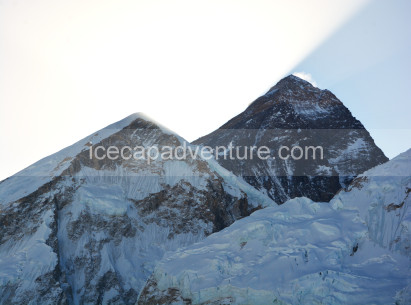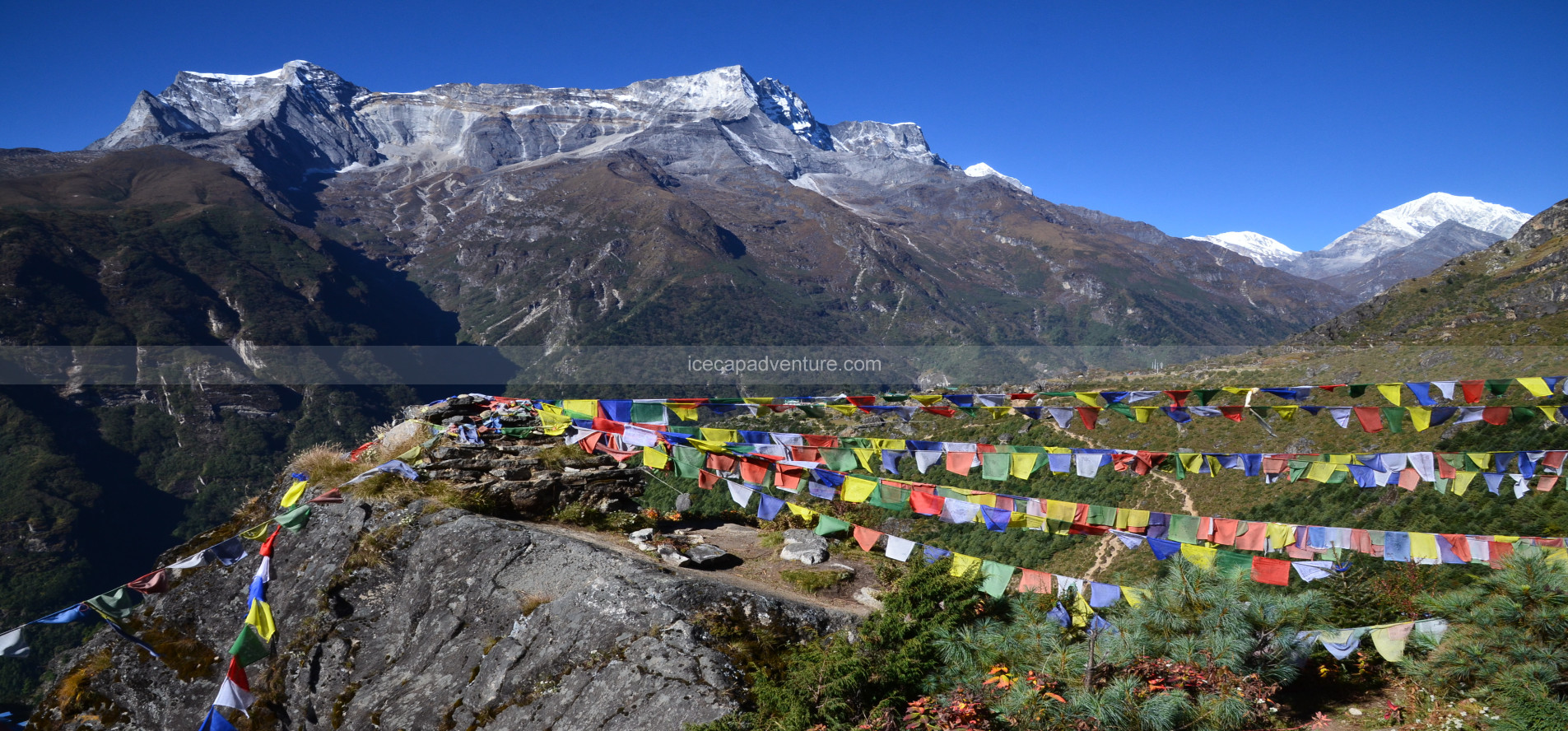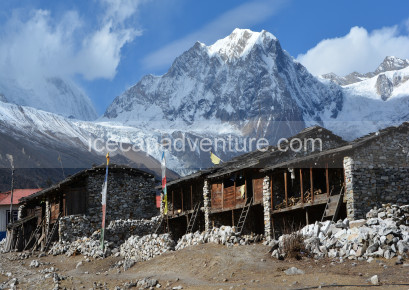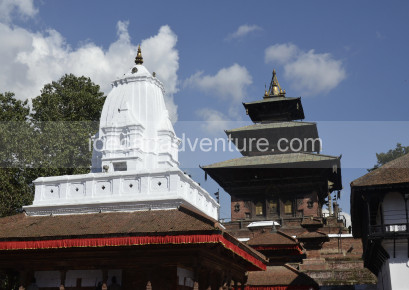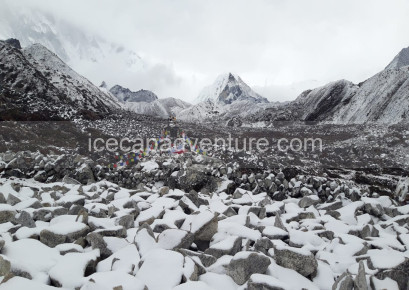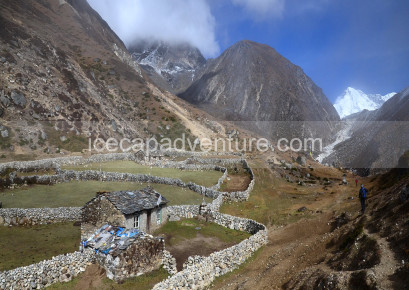.png)
.png)
.png)
.png)
.png)
.png)
.png)
.png)
Jiri to Everest Base Camp Trek: The Classic Route to the Top of the World
Walk in the footsteps of legendary mountaineers with the Jiri to Everest Base Camp Trek, the original route followed by Sir Edmund Hillary and Tenzing Norgay during their historic 1953 Everest expedition. Known as the “Classic Everest Trail,” this journey from Jiri to Everest Base Camp offers trekkers an authentic experience through rural Nepal before reaching the majestic Khumbu region. It’s an adventure that blends cultural encounters, spiritual landmarks, and jaw-dropping Himalayan scenery.
The Classic Journey from Jiri to the Everest Region
The adventure begins with a scenic overland drive from Kathmandu to Jiri, a charming hill town surrounded by lush forests and terraced fields. Often called the “Switzerland of Nepal,” Jiri marks the traditional starting point of the Everest trek. From here, the trail winds through picturesque villages like Bhandar, Sete, Junbesi, and Nunthala, where trekkers can experience the authentic rural lifestyle of Nepal’s hill communities.
As the route ascends, the landscape transitions from subtropical greenery to alpine terrain. You’ll pass through ancient monasteries, suspension bridges, and dense rhododendron forests while enjoying spectacular mountain views. This gradual ascent provides perfect acclimatization, making it an excellent choice for trekkers seeking a true Himalayan experience without rushing to altitude.
Entering the Khumbu: Namche Bazaar and Beyond
After several rewarding days on the trail, the route joins the main Everest Base Camp trail at Namche Bazaar, the lively heart of the Khumbu region. Known as the “Gateway to Everest,” Namche is a vibrant mountain hub filled with teahouses, shops, bakeries, and cultural museums. Trekkers can acclimatize here while exploring nearby viewpoints like the Everest View Hotel, where Everest, Ama Dablam, and Thamserku create a breathtaking panorama.
From Namche, the trail ascends through rhododendron forests and quaint Sherpa settlements to reach Tengboche Monastery, the spiritual center of the Everest region. Surrounded by snowy peaks and prayer flags fluttering in the breeze, this monastery offers both peace and stunning photo opportunities.
Reaching the Foot of Mount Everest
As the journey continues, the trail passes through Dingboche, Lobuche, and Gorak Shep, leading finally to the legendary Everest Base Camp (5,364m). Here, you’ll stand beneath the awe-inspiring Khumbu Icefall and gaze upon the dramatic peaks of the world’s highest mountain range. For the ultimate highlight, an early morning hike to Kala Patthar (5,545m) rewards you with an unforgettable sunrise view over Mount Everest and its neighboring giants—an experience every trekker dreams of.
Culture, Spirituality, and Sherpa Heritage
One of the most rewarding aspects of the Jiri to EBC Trek is the opportunity to engage deeply with Sherpa culture. Along the way, trekkers stay in family-run teahouses, savor authentic Nepali meals, and learn about the mountain traditions that have shaped life in the Himalayas for centuries. Ancient monasteries, colorful prayer flags, and friendly smiles accompany you at every step of the journey.
Why Choose the Jiri to Everest Base Camp Trek
Unlike the fly-in route to Lukla, the Jiri to Everest Base Camp Trek allows travelers to appreciate the full geographical and cultural diversity of Nepal. This longer, more immersive route offers gradual acclimatization, fewer crowds, and an intimate connection with both the people and the mountains. It’s ideal for those who want to experience the Everest region in its purest and most traditional form.
Trip Highlights:
-
Follow the original route of the 1953 Everest Expedition taken by Sir Edmund Hillary and Tenzing Norgay.
-
Enjoy a scenic drive from Kathmandu to Jiri, the gateway to the classic Everest trail.
-
Trek through traditional villages such as Bhandar, Sete, Junbesi, and Nunthala and experience authentic local life.
-
Explore the bustling mountain town of Namche Bazaar, the Sherpa capital of the Everest region.
-
Visit Tengboche Monastery, one of the most sacred Buddhist monasteries in the Himalayas.
-
Reach the legendary Everest Base Camp (5,364m) and stand beneath the Khumbu Icefall.
-
Hike to Kala Patthar (5,545m) for a spectacular sunrise view of Mount Everest and surrounding peaks.
-
Immerse yourself in Sherpa culture, Buddhist spirituality, and traditional Himalayan hospitality.
-
Enjoy a gradual ascent that helps with acclimatization and allows time to truly experience Nepal’s beauty.
1
We will be waiting to welcome you at Tribhuvan International Airport, Kathmandu, where you will be greeted with a traditional Nepali flower garland to mark your arrival. After the warm welcome, we will drive you to your hotel—approximately 30 minutes during the day and 20 minutes at night.
Upon reaching the Hotel, you will be offered welcome drinks and biscuits, followed by the settlement of your rooms. Once settled, please join us back in the lobby or meeting hall for a briefing about your trekking and tour program on Jiri to EBC Trek, including an introduction to your trekking guide and other relevant details.
After the briefing, you will have the opportunity to check your trekking equipment with your guide.
Note: If you arrive in Kathmandu at night, these activities will be scheduled for the following day after breakfast and meals.
.png)
.png)
.png)
.png)
2
After breakfast at the hotel, you will have time to explore Kathmandu’s cultural heritage sites, such as Kathmandu Durbar Square, Swayambhunath (Monkey Temple), or Boudhanath Stupa, and you will have the day to prepare for your trek.
Our team will assist you in checking your gear and ensuring you have all the necessary equipment for the journey ahead. If you need to buy or rent any trekking gear, we will guide you to the best shops in Thamel, where you can find quality items at reasonable prices.
In the evening, your trekking guide will conduct a final briefing about the trek, including route details, safety measures, and expected weather conditions. Overnight stay at a hotel in Kathmandu.
.png)
.png)
.png)
.png)
3
After an early breakfast, your adventure begins with a scenic drive from Kathmandu to Bhandar, passing through charming towns and lush countryside. The journey takes approximately 8 to 9 hours, covering winding mountain roads and offering breathtaking views of terraced hillsides, local villages, and distant Himalayan peaks.
The route follows the Araniko Highway towards Jiri, often referred to as the “Gateway to Everest,” and continues onward to Bhandar, a beautiful Sherpa and Tamang village surrounded by rolling green hills and peaceful farmland.
Upon arrival, you’ll settle into a local teahouse or lodge, where you can relax and enjoy the tranquil mountain atmosphere while preparing for the upcoming trekking days.
Highlights of the Day
-
Long but scenic countryside drive from Kathmandu
-
Panoramic views of terraced hills, rivers, and distant peaks
-
Experience local village life along the way
-
Overnight stay in the peaceful village of Bhandar
.png)
.png)
.png)
.png)
4
After a peaceful morning in Bhandar (2,190m), today’s trek leads you through charming mid-hill landscapes, traditional villages, and lush terraced farmlands on the way to Sete (2,645m). The journey offers a perfect blend of cultural encounters and natural beauty, showcasing the rural heart of Nepal far from the bustling trails of higher altitudes.
The trail begins with a gentle descent through scattered villages and farmlands filled with barley, wheat, and millet crops. As you pass through Dokharpa and Baranda, you’ll witness local life in motion — farmers working the fields, children playing, and traditional homes adorned with prayer flags fluttering in the breeze. After crossing a small stream, the path gradually ascends through forests of rhododendron, pine, and oak, offering cool shade and occasional glimpses of distant mountain ridges.
The climb to Sete is steady but not overly demanding, and you’ll be rewarded with a warm welcome upon arrival at this quaint Sherpa settlement. Sete is beautifully located on a forested ridge, providing panoramic views and a serene environment to rest and prepare for the steeper climbs ahead toward Lamjura La Pass.
Highlights of the Day
-
Trek through traditional villages and terraced farmlands
-
Experience authentic rural Nepalese lifestyle and culture
-
Gradual ascent through lush rhododendron and pine forests
-
Peaceful overnight stay at Sete (2,645m), surrounded by hills and valleys
-
Perfect acclimatization and preparation for the next day’s ascent toward Lamjura La
.png)
.png)
.png)
.png)
5
Today’s trek takes you from Sete through peaceful forests and traditional Sherpa villages toward Junbesi (2,675m). The trail weaves through rhododendron and pine forests, past small streams and terraced farmland, giving you a serene experience of rural Himalayan life. Along the way, you’ll enjoy scenic mountain views and the calm atmosphere of remote villages tucked between rolling hills.
The path gradually descends and then gently rises, making it a comfortable day for walking while still offering plenty of opportunities to soak in the surrounding natural beauty. Arriving in Junbesi, you’ll find a quaint Sherpa village with traditional monasteries, local shops, and welcoming lodges — an ideal place to rest and experience the culture of the Solu-Khumbu region.
Highlights of the Day
-
Trek through tranquil forests of rhododendron, pine, and oak
-
Explore charming Sherpa villages along the trail
-
Experience traditional Himalayan rural life and culture
-
Enjoy panoramic views of hills and distant peaks
-
Overnight stay in Junbesi (2,675m), a serene Sherpa settlement
.png)
.png)
.png)
.png)
6
Today’s trek leads you from Junbesi through verdant forests and traditional villages to Taksindu (2,440m), a picturesque settlement offering a peaceful atmosphere and views of the surrounding hills. The trail meanders along gentle slopes, passing streams, terraced fields, and quaint local homes, giving you an authentic glimpse of rural Himalayan life.
The path descends gradually before a mild ascent, making it a pleasant walking day suitable for acclimatization. Along the way, you can admire the majestic views of distant peaks, hear the rhythmic chants from nearby monasteries, and enjoy the serenity of the forested trail. Taksindu, with its warm and welcoming teahouses, provides a comfortable stopover and an opportunity to engage with the local Sherpa community.
Highlights of the Day
-
Trek through lush forests of pine and rhododendron
-
Pass traditional Sherpa villages and terraced farmlands
-
Admire distant mountain views and peaceful Himalayan landscapes
-
Experience local culture and hospitality in a tranquil setting
-
Overnight stay in Taksindu (2,440m), a serene village surrounded by hills
.png)
.png)
.png)
.png)
7
Today’s trek descends from Taksindu through lush forests and terraced farmlands to Kharikhola (2,020m), a charming village nestled along the banks of the Dudh Koshi River. The trail offers a blend of natural beauty and cultural encounters, passing through small settlements where locals tend their fields and traditional houses display the region’s rich Sherpa heritage.
The path is mostly downhill with gentle ascents, making it a comfortable trekking day. You’ll enjoy shaded forest trails, flowing streams, and glimpses of distant peaks, all while observing daily rural life in the Solu-Khumbu region. Kharikhola, perched on a hillside, provides cozy teahouses, warm hospitality, and a perfect spot to relax and reflect on your journey so far.
Highlights of the Day
-
Trek through dense pine and rhododendron forests
-
Pass terraced fields and traditional Sherpa villages
-
Experience authentic rural Himalayan life
-
Enjoy river views and scenic landscapes along the trail
-
Overnight stay in Kharikhola (2,020m), a peaceful riverside village
.png)
.png)
.png)
.png)
8
Today’s trek leads from Kharikhola through dense forests, rolling hills, and terraced farmland toward Paiyu (2,700m). The trail gradually ascends, offering a moderate challenge along the way, while rewarding trekkers with stunning views of the surrounding valleys and distant Himalayan peaks.
The path winds through small Sherpa settlements, where you can observe traditional lifestyles, prayer flags fluttering along the trails, and glimpses of local monasteries. As you approach Paiyu, the landscape opens to panoramic ridge-top views, making this a particularly scenic section of the trek. Paiyu is a quiet mountain village with welcoming teahouses, providing a comfortable overnight stop and a chance to rest before continuing toward higher altitudes.
Highlights of the Day
-
Trek through forests of pine, rhododendron, and oak
-
Pass traditional Sherpa villages and terraced farmlands
-
Scenic ridge-top views and glimpses of Himalayan peaks
-
Experience local culture, monasteries, and rural life
-
Overnight stay in Paiyu (2,700m), a serene hillside village
.png)
.png)
.png)
.png)
9
Today’s trek takes you from Paiyu down through lush forests, terraced farmland, and scenic valleys to Phakding (2,646m), a key stop on the trail toward Namche Bazaar. The trail follows the Dudh Koshi River for much of the day, offering serene river views and glimpses of traditional Sherpa villages along the way.
The path features gentle descents interspersed with short uphill stretches, making it a comfortable walking day. You’ll pass suspension bridges, small monasteries, and prayer wheels, adding cultural highlights to the journey. Upon arrival in Phakding, you’ll find cozy teahouses and a friendly local community, perfect for rest and acclimatization before ascending to Namche Bazaar the next day.
Highlights of the Day
-
Trek along the Dudh Koshi River, enjoying tranquil water views
-
Cross suspension bridges and pass traditional Sherpa villages
-
Walk through forests of pine, rhododendron, and oak
-
Observe monasteries, prayer wheels, and local culture
-
Overnight stay in Phakding (2,646m), a peaceful village on the main Everest trekking route
.png)
.png)
.png)
.png)
10
Today’s trek is one of the most exciting sections of the Everest region, taking you from Phakding through picturesque river valleys, lush forests, and traditional Sherpa settlements to Namche Bazaar (3,440m), the vibrant hub of the Khumbu region. The trail follows the Dudh Koshi River and crosses multiple suspension bridges, offering stunning views of snow-capped peaks along the way.
The route includes a steady climb through forested trails and terraced villages, which helps with acclimatization before reaching Namche Bazaar. Upon arrival, you’ll be greeted by the bustling atmosphere of this famous Sherpa town, complete with shops, cafes, and local markets. Namche serves as the gateway to Everest Base Camp treks and provides an excellent spot for rest, acclimatization, and exploring Sherpa culture.
Highlights of the Day
-
Trek along the Dudh Koshi River, crossing iconic suspension bridges
-
Ascend through forests of rhododendron, pine, and oak
-
Pass traditional Sherpa villages and observe local life
-
Stunning views of snow-capped Himalayan peaks along the route
-
Arrive in Namche Bazaar (3,440m), the bustling Sherpa town and trekking hub
.png)
.png)
.png)
.png)
11
Today is a rest and acclimatization day at Namche Bazaar (3,440m), allowing your body to adjust to higher altitudes while exploring the cultural and natural highlights of the region. This day combines gentle trekking, sightseeing, and breathtaking Himalayan vistas, making it both relaxing and enriching.
You’ll take short treks to nearby villages such as Khumjung and Khunde, passing through terraced fields, pine and rhododendron forests, and traditional Sherpa settlements. In Khumjung, you can visit the famous Hillary School and local monastery, while Khunde is home to a small hospital and charming village life. From these vantage points, you can enjoy spectacular views of Mount Everest, Ama Dablam, and other Himalayan giants, offering perfect photo opportunities.
Returning to Namche Bazaar in the afternoon, you can explore its shops, cafes, and markets, interact with local Sherpa families, and enjoy the vibrant atmosphere of this iconic trekking hub.
Highlights of the Day
-
Acclimatization and gentle trekking around Namche Bazaar
-
Visit Khumjung and Khunde villages and experience Sherpa culture
-
Explore local monasteries and the Hillary School
-
Panoramic views of Mount Everest, Ama Dablam, and surrounding peaks
-
Leisure time to explore Namche Bazaar’s shops, markets, and cafes
.png)
.png)
.png)
.png)
12
Today’s trek takes you from Namche Bazaar through stunning alpine forests and traditional Sherpa villages to the iconic Tengboche Monastery (3,790m). The trail gradually ascends through rhododendron, pine, and juniper forests, offering spectacular views of Ama Dablam, Thamserku, and Mount Everest along the way.
Passing through small villages and prayer-flag-lined trails, you’ll witness the local Sherpa lifestyle and the spiritual ambiance of the region. Upon arrival in Tengboche, the famous monastery perched on a ridge overlooking the Dudh Koshi valley offers a serene setting with breathtaking Himalayan panoramas — one of the most photographed spots in the Everest region.
This is also an ideal location for rest, acclimatization, and photography, capturing the iconic vistas of Everest and surrounding peaks.
Highlights of the Day
-
Trek through forests of rhododendron, pine, and juniper
-
Pass traditional Sherpa villages and prayer-flag trails
-
Visit the famous Tengboche Monastery with panoramic Himalayan views
-
Enjoy spectacular vistas of Mount Everest, Ama Dablam, and Thamserku
-
Overnight stay in Tengboche (3,790m), a spiritual and scenic stop
.png)
.png)
.png)
.png)
13
Today’s trek leads you from the spiritual hub of Tengboche through breathtaking alpine terrain to Dingboche (4,350m), a serene village nestled in the Imja Valley. The trail is mostly gradual ascent, passing through stone villages, mani walls, and yak pastures, offering a true sense of high-altitude Himalayan life.
Along the way, you’ll enjoy panoramic views of Ama Dablam, Lhotse, and Island Peak, and cross small streams and terraced fields. Dingboche is an important acclimatization stop on the Everest Base Camp trek, providing an opportunity to rest, adjust to the higher altitude, and prepare for the challenging climb ahead. The village’s traditional stone houses and quiet surroundings create a peaceful atmosphere for reflection and photography.
Highlights of the Day
-
Trek through stone villages, mani walls, and yak pastures
-
Experience high-altitude Sherpa culture and traditional Himalayan life
-
Stunning views of Ama Dablam, Lhotse, and Island Peak
-
Gentle ascent for acclimatization before higher elevations
-
Overnight stay in Dingboche (4,350m), a peaceful alpine village
.png)
.png)
.png)
.png)
14
Today’s trek takes you from Dingboche through high-altitude alpine terrain to Lobuche (4,910m), a small settlement near the glaciers of the Khumbu region. The trail is relatively short but involves steady ascent, helping trekkers acclimatize as they approach Everest Base Camp.
You’ll pass rocky paths, moraine trails, and sparse vegetation, experiencing the stark beauty of the high Himalayas. Along the way, you can admire the towering peaks of Pumori, Nuptse, and Khumbutse, and observe the daily lives of Sherpa and yak herders in this remote area. Lobuche’s basic teahouses provide a comfortable stop for rest, offering stunning sunset and sunrise views over the surrounding mountains.
Highlights of the Day
-
Trek through high-altitude rocky and moraine trails
-
Acclimatize at 4,910m before continuing to Everest Base Camp
-
Spectacular views of Pumori, Nuptse, and Khumbutse
-
Observe Sherpa villages, yak pastures, and high Himalayan landscapes
-
Overnight stay in Lobuche (4,910m), a remote alpine settlement
.png)
.png)
.png)
.png)
15
Today’s trek takes you from Lobuche to Gorak Shep (5,140m), the last settlement before reaching Everest Base Camp. Although the distance is short, the trail is challenging due to high altitude and rocky, uneven terrain. The route follows the Khumbu Glacier, offering breathtaking views of Mount Nuptse, Pumori, and Khumbutse, along with glimpses of Everest’s upper slopes.
As you ascend gradually, the landscape becomes barren yet awe-inspiring — a true representation of the Himalayan wilderness. Upon reaching Gorak Shep, you’ll settle into your teahouse and rest for the day, preparing for the upcoming Everest Base Camp hike or the Kalapatthar viewpoint climb. The location offers dramatic scenery, with the icy walls of the Khumbu Glacier nearby and the majestic Everest region towering above.
Highlights of the Day
-
Trek along the Khumbu Glacier with jaw-dropping mountain panoramas
-
Spectacular views of Mount Pumori, Nuptse, and Khumbutse
-
Experience high-altitude Himalayan terrain above 5,000 meters
-
Reach Gorak Shep (5,140m), the last stop before Everest Base Camp
-
Overnight stay surrounded by glaciers and towering peaks
.png)
.png)
.png)
.png)
16
After experiencing the incredible heights of Everest, today’s journey takes you down from Gorak Shep (5,140m) to the charming village of Pheriche (4,240m). The descent is both refreshing and scenic, offering a new perspective on the Himalayan landscapes you crossed earlier.
You’ll retrace your steps past Lobuche and descend through glacial valleys, rocky moraines, and alpine meadows. As you lose altitude, the air becomes richer in oxygen, making breathing easier and walking more comfortable. Along the trail, enjoy splendid views of Ama Dablam, Thamserku, and Taboche, as well as prayer flags fluttering across the ridges.
Pheriche is a well-known stop for trekkers and climbers, home to the Himalayan Rescue Association, where you can learn about altitude and mountain safety. It’s also a peaceful place to rest after several days of high-altitude trekking.
Highlights of the Day
-
Descend from Gorak Shep (5,140m) to Pheriche (4,240m)
-
Trek through glacial valleys and alpine meadows
-
Breathtaking views of Ama Dablam, Thamserku, and Taboche
-
Visit the Himalayan Rescue Association center in Pheriche
-
Enjoy a well-deserved rest at a lower, more comfortable altitude
.png)
.png)
.png)
.png)
17
Today’s trek takes you from the high alpine village of Pheriche (4,240m) back to the vibrant Sherpa hub of Namche Bazaar (3,440m). The journey descends gradually through beautiful valleys, rhododendron forests, and suspension bridges, retracing part of your earlier route while offering a whole new perspective of the stunning Himalayan scenery.
As you descend, you’ll feel the air getting warmer and thicker, making the trek more comfortable and relaxing. Along the way, you’ll pass charming villages like Orsho, Pangboche, and Tengboche, each offering glimpses of local monasteries, prayer flags, and yak herders. After crossing the Dudh Koshi River and climbing a final short stretch, you’ll arrive back in Namche Bazaar, where you can unwind, enjoy a hot shower, and reconnect with fellow trekkers.
Highlights of the Day
-
Descend from Pheriche (4,240m) to Namche Bazaar (3,440m)
-
Walk through lush rhododendron and pine forests
-
Visit Tengboche Monastery and other Sherpa villages en route
-
Cross suspension bridges over the Dudh Koshi River
-
Relax in Namche Bazaar, the bustling heart of the Khumbu region
.png)
.png)
.png)
.png)
18
Today marks the final day of your Everest trekking journey, as you make your way from Namche Bazaar (3,440m) down to Lukla (2,630m). The trail descends steeply through dense pine and rhododendron forests, crossing suspension bridges draped with prayer flags over the rushing Dudh Koshi River.
You’ll pass through the familiar villages of Monjo, Phakding, and Chheplung, where the warm smiles of the locals and the comforting sounds of the river accompany your final steps in the Khumbu region. The path is mostly downhill, with a few short climbs before reaching Lukla. Upon arrival, you can celebrate the successful completion of your Everest trek with your team, reflecting on the incredible journey through the Himalayas.
Highlights of the Day
-
Final trek through Sherpa villages and lush mountain forests
-
Cross iconic suspension bridges over the Dudh Koshi River
-
Enjoy a mix of cultural and natural scenery along the descent
-
Reflect on your journey as you return to Lukla (2,630m)
-
Celebrate the completion of your Everest trekking adventure
.png)
.png)
.png)
.png)
19
After breakfast, you’ll head to Lukla Airport (Tenzing-Hillary Airport) for your scenic mountain flight back to Kathmandu. The short yet spectacular flight offers one last chance to admire the majestic Himalayan panorama, including distant views of Everest, Lhotse, and Ama Dablam, before leaving the mountains behind.
Upon landing in Kathmandu (1,350m), you’ll be transferred to your hotel in the city. The rest of the day is yours to relax, enjoy a warm shower, or explore the vibrant streets of Thamel. You can indulge in delicious local or international cuisine, do some souvenir shopping, or simply unwind and reflect on your incredible Everest trekking adventure.
Highlights of the Day
-
Scenic mountain flight from Lukla to Kathmandu (40–45 minutes)
-
Final panoramic views of the Himalayan range from the air
-
Safe return to the bustling city life of Kathmandu
-
Leisure time for relaxation, reflection, or shopping in Thamel
-
Comfortable hotel stay after the mountain journey
.png)
.png)
.png)
.png)
20
After your remarkable Himalayan adventure, today is a well-deserved rest and leisure day in Kathmandu. Take time to relax and rejuvenate your body after days of trekking through the mountains. Enjoy a hearty breakfast at your hotel, followed by a day at your own pace — whether you prefer souvenir shopping, exploring cultural sites, or simply unwinding in one of the city’s cozy cafés.
You can stroll through Thamel, the lively heart of Kathmandu, where colorful shops offer handicrafts, pashminas, Thanka paintings, trekking gear, and jewelry. If you wish, you can also visit some of the city’s UNESCO World Heritage Sites, such as Kathmandu Durbar Square, Swayambhunath (Monkey Temple), or Boudhanath Stupa.
In the evening, you may enjoy a farewell dinner with your trekking team, celebrating your successful journey in the Everest region and the unforgettable experiences you’ve gained.
Highlights of the Day
-
Relax and rejuvenate after your long trekking adventure
-
Explore Thamel’s vibrant markets for souvenirs and local crafts
-
Optional sightseeing to UNESCO Heritage Sites in Kathmandu Valley
-
Enjoy local cuisine or coffee in cozy restaurants and cafés
-
Reflect on your memorable Himalayan experience
.png)
.png)
.png)
.png)
21
Your Himalayan adventure comes to a close today. After breakfast, depending on your flight schedule, you will be transferred to Tribhuvan International Airport for your departure flight home or to your next destination.
Take with you unforgettable memories of Nepal — the majestic mountains, warm Sherpa hospitality, and the spiritual tranquility of the Himalayas. If you have extra time, you can enjoy a final stroll around Thamel for some last-minute shopping or relaxation before your journey.
Your trekking team will bid you farewell, wishing you a safe flight and hoping to welcome you back to Nepal for another incredible adventure in the future.
Highlights of the Day
-
Airport transfer for your international departure
-
Final moments to shop, relax, or explore around Thamel
-
Reflect on your amazing Himalayan journey and cultural experiences
-
Farewell from your guides and trekking team
-
Departure with lifelong memories of Nepal
.png)
.png)

Didn’t find what you were looking for?
So why not plan your own trip. It takes only 2 minutes.- Airport Pick up and transfers to hotel.
- All accommodation in Kathmandu and Trekking.
- Full board meals during the trekking such as : Breakfast, Lunch and Dinner.
- Properly 3 times tea and coffee whatever hot drinks are available.
- Climb up to Kalapattar and View of Khumbu Himalayan range
- Experience professional guide.
- Full insurance for guide and porter. All transportation from the starting to ending points of the trip.
- Full support crew with 1 porter for every 2 trekker.
- All transportation from the starting to ending points of the trip.
- Trekking Map and Notebook
- Domestic flight ticket from Lukla to Kathmandu.
- First Aid Kit for staff.
- National park entry fee and TIMS card or trekking permit whatever needed.
- Down Sleeping bag (-20), must be returned after completing the trek.
- Trekking achievement certificate after completed the Treks.
- International flight tickets, Travel insurance and Nepal entry visa fees.
- Lunch and dinner in Kathmandu.
- All hard drinks such as : Mineral water, whisky, rum, cola, fanta, etc.
- Extra entrance fees such as Museum, Monastry, Temple, Boating, etc
- Personal expenses like hot shower and battery charge/wifi.
- Personal equipment
- Extra night hotel in Kathmandu if arriving early or late departure than scheduled itinerary.
- Any emergency rescue evacuation and extra cost offering from unfavorable circumstance such as weather bad.
- Personal tips for trekking staff.
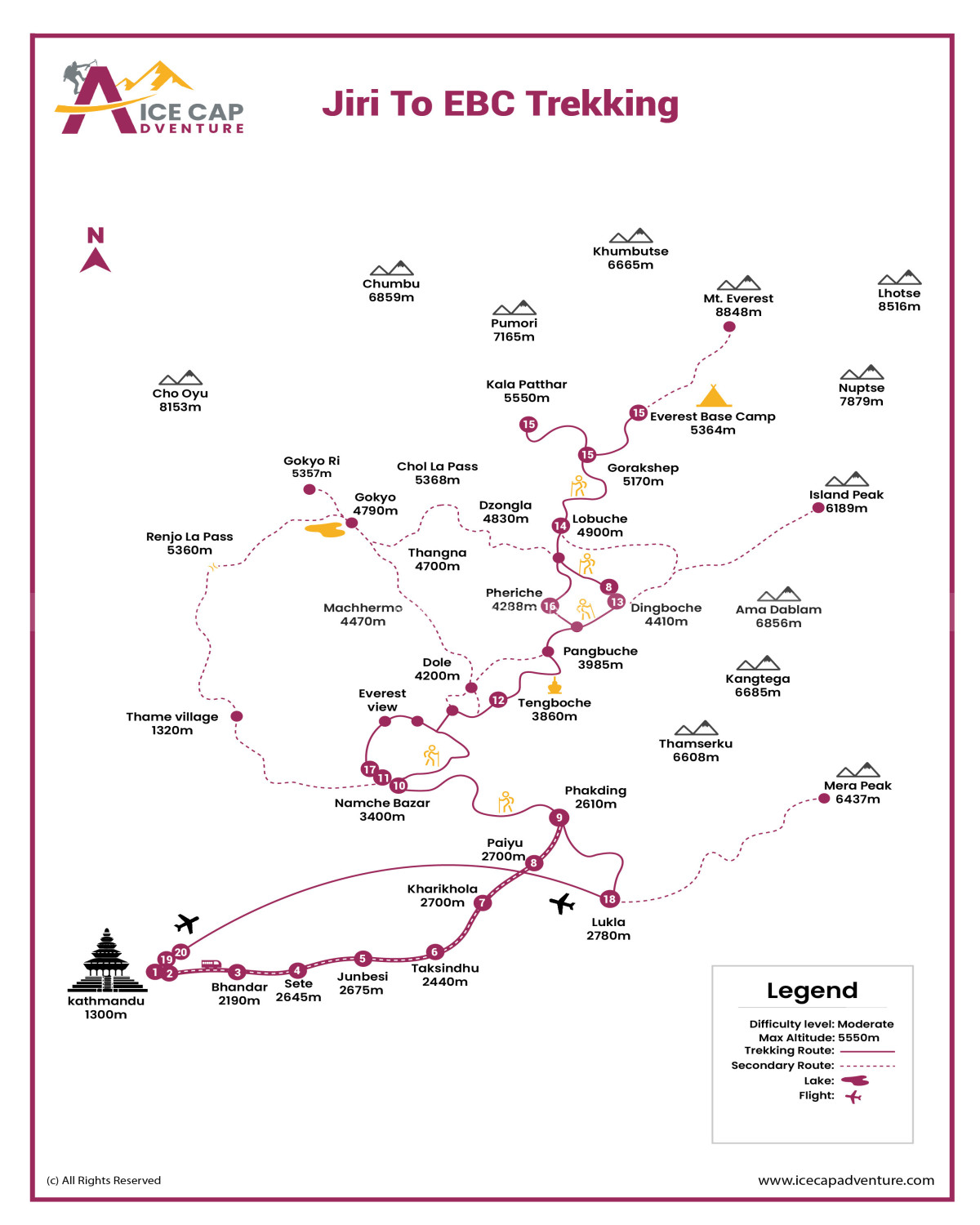

✅ Clothing
-
Base Layers (Thermal Tops & Bottoms)
-
Trekking Shirts (Long & Short Sleeves)
-
Fleece Jacket / Warm Mid-layer – For insulation.
-
Down Jacket – Essential for nights above 3,500m.
-
Waterproof & Windproof Jacket (with hood).
-
Trekking Pants (lightweight, quick-drying).
-
Warm Trekking Pants (for high altitude).
-
Waterproof Pants (for rain/snow).
-
Underwear – Comfortable, quick-dry.
-
Sports Bras (for women).
✅ Head & Hand Wear
-
Warm Hat / Beanie and Sun Hat / Cap.
-
Buff / Neck Gaiter / Scarf.
-
Sunglasses and Gloves 2 pairs
✅ Footwear
-
Trekking Boots – Sturdy, waterproof, broken-in.
-
Lightweight Shoes / Sandals – For camp/teahouse.
-
Warm Trekking Socks – At least 4–5 pairs.
✅ Sleeping & Bags
-
Sleeping Bag (Down -15°C) and Liner.
-
Duffel Bag (carried by porter).
-
Daypack (30–40L) – For personal items.
-
Rain Cover for Backpack.
✅ Trekking Gear
-
Trekking Poles & Gaiters – For snow or muddy.
-
Headlamp (with extra batteries).
-
Water Bottles (2–3 liters) and Water Purifications.
-
Personal First Aid Kit
-
Snacks / Energy Bars / Dry Fruits.
✅ Accessories & Personal Items
-
Sunscreen (SPF 30–50) and Lip Balm with SPF.
-
Toiletries and Hand Sanitizer.
-
Towel (quick-dry) and Toilet Paper
-
Camera / Power Bank / Solar Charger.
✅ Documents & Money
-
Valid Passport and Visa.
-
Travel Insurance (cover high-altitude & helicopter rescue).
-
Cash (Nepali Rupees) – For personal expenses.
Good to Know – Jiri to Everest Base Camp Trekking
-
Best Seasons to Trek:
The Jiri to Everest Base Camp Trek is best undertaken during spring (March–May) and autumn (September–November). These months offer stable weather, clear skies, and breathtaking Himalayan views. Winter brings freezing temperatures and snow, while the monsoon season (June–August) can make trails muddy and slippery. -
Altitude Awareness:
The trek reaches a maximum altitude of 5,364 meters at Everest Base Camp, so gradual acclimatization is vital. The longer Jiri route helps the body adjust naturally, but rest days in Namche Bazaar and Dingboche are still recommended to avoid acute mountain sickness (AMS). -
Physical Fitness:
This is a long and strenuous trek, suitable for trekkers with excellent fitness levels and previous trekking experience. Expect 6–8 hours of walking daily, including steep ascents, rocky trails, and high passes. -
Permits Required:
Trekkers require a Sagarmatha National Park Entry Permit and a TIMS (Trekkers’ Information Management System) card. These can be obtained in Kathmandu or at Monjo (park entrance). -
Accommodation and Meals:
The route is lined with teahouses and lodges, offering simple rooms, shared bathrooms, and local meals such as dal bhat, noodles, soup, rice, pasta, and tea/coffee. At higher altitudes, food becomes more basic and pricier. -
Drinking Water:
Water is available in villages, but always use purification tablets or filters. Bottled water is available in some areas but becomes expensive at higher elevations. Carry a reusable bottle to reduce plastic waste. -
Packing and Gears:
Essential gear includes trekking boots, warm layered clothing, down jacket, gloves, hat, sunglasses, trekking poles, sleeping bag (-15°C), headlamp, sunscreen, power bank, and a basic first aid kit. A rain jacket is recommended, especially if trekking in the shoulder seasons. -
Transportation and Route:
The journey begins with a drive from Kathmandu to Jiri or Bhandar (6–8 hours), then trekking through Solu villages, forests, and terraced hillsides before joining the main Everest trail at Lukla or Phakding. The route passes through Namche Bazaar, Tengboche, Dingboche, Lobuche, and Gorak Shep, finally reaching Everest Base Camp and Kala Patthar (5,545m) for panoramic views of Mt. Everest. -
Travel Insurance:
Comprehensive trekking insurance covering high-altitude evacuation, medical treatment, and trip delays is mandatory for this trek due to its remoteness and altitude. -
Connectivity and Charging:
Mobile networks are available in major villages like Namche Bazaar and Tengboche, but connectivity is limited beyond that. Most teahouses provide charging facilities for a small fee — carrying a power bank or solar charger is highly recommended. -
Highlight Experience:
The Jiri to Everest Base Camp Trek is known as the classic route followed by early Everest pioneers like Sir Edmund Hillary and Tenzing Norgay. It offers a rich cultural experience, diverse landscapes, Sherpa hospitality, and scenic beauty long before reaching the Khumbu highlands. It’s ideal for trekkers seeking a less crowded, more authentic journey to the world’s highest peak.

